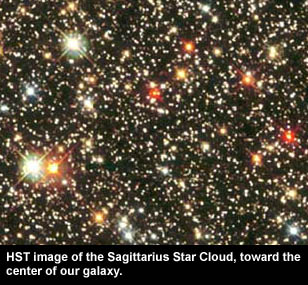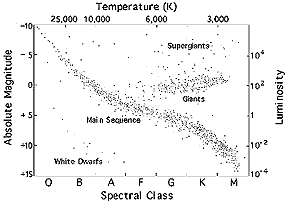AstroCappella: Wolf 359
 There are billions of stars in our Galaxy, and it's sometimes hard to get
an idea of how big our Galaxy and our Universe are just by looking out
there at the stars. When you look up at the sky on a dark night, you see
many points of light. At first glance you might think they're all the
same: far-away white stars on a black background. But if you look closely,
you might notice that some are a bit brighter, some a bit dimmer, some are
a little redder, some bluer. If you've listened to "Doppler Shifting" you
may think that those that appear redder are red-shifted, moving away from
us, and those that appear bluer are moving toward us. And common
experience might lead you to conclude that the bright ones are close and
the dim ones are far. But that's not necessarily the case.
There are billions of stars in our Galaxy, and it's sometimes hard to get
an idea of how big our Galaxy and our Universe are just by looking out
there at the stars. When you look up at the sky on a dark night, you see
many points of light. At first glance you might think they're all the
same: far-away white stars on a black background. But if you look closely,
you might notice that some are a bit brighter, some a bit dimmer, some are
a little redder, some bluer. If you've listened to "Doppler Shifting" you
may think that those that appear redder are red-shifted, moving away from
us, and those that appear bluer are moving toward us. And common
experience might lead you to conclude that the bright ones are close and
the dim ones are far. But that's not necessarily the case.
There are a variety of star types in our Galaxy. Some are hot and bright and burn for a short time (relatively speaking, of course!). Some are cool and dim and burn a long time. Some have incredibly strong stellar winds that cause the star to lose a large percentage of its mass over its lifetime. Some are the cooling cinders of stars, and some are just being born from nebulae of gas.
Magnitudes
First, let's talk about how bright stars are. When you look into the sky and see a bright star, there may be several reasons that it looks bright. The first and most obvious is that it's close by. But it also might be that it's intrinsically brighter (or more luminous). We assign a luminosity number (or magnitude) to stars to say how bright they are. We can assign an apparent magnitude - that's how bright they appear to be from Earth. But it's scientifically much more useful to calculate an Absolute Magnitude, which is the brightness a star would have if it were at a distance of 10 parsecs. (A parsec is equal to 3.26 light years, a little less than the distance to the nearest star to the Sun.) Then the Absolute Magnitude is directly related to the star's luminosity. In the magnitude system, the lower the number, the brighter the star.
The H-R Diagram and Spectral Types
In 1913, two astronomers independently determined that there was a link between the luminosities (or absolute magnitudes) of stars and their spectral class (based on temperature). A plot of this relationship is called a Hertzsprung-Russell (or H-R) diagram and is named after these two astronomers.
 By plotting stars' absolute magnitude against their spectral type, one can
see that most stars fall along a diagonal strip from high temperature,
high luminosity stars to low temperature, low luminosity stars. These are
the main sequence stars. Our star is one of them. There are a few stars
that are not in this diagonal strip. There are some low temperature, high
luminosity stars - these are called giants and supergiants. The reason
they are so luminous while being relatively cool is because they're so big
(50 times more massive than our Sun). Another group of stars are in the
high temperature, low luminosity corner of the diagram. Since these stars
are hot, but not very luminous, they must be very small, so they're called
white dwarfs. The star called Antares is a supergiant and is almost 7000
times the radius of Proxima Centauri, a red dwarf in the Alpha Centauri
system.
By plotting stars' absolute magnitude against their spectral type, one can
see that most stars fall along a diagonal strip from high temperature,
high luminosity stars to low temperature, low luminosity stars. These are
the main sequence stars. Our star is one of them. There are a few stars
that are not in this diagonal strip. There are some low temperature, high
luminosity stars - these are called giants and supergiants. The reason
they are so luminous while being relatively cool is because they're so big
(50 times more massive than our Sun). Another group of stars are in the
high temperature, low luminosity corner of the diagram. Since these stars
are hot, but not very luminous, they must be very small, so they're called
white dwarfs. The star called Antares is a supergiant and is almost 7000
times the radius of Proxima Centauri, a red dwarf in the Alpha Centauri
system.
The spectral class of stars from high temperature to low temperature is often depicted by the letters O, B, A, F, G, K, and M. O stars and B stars are very hot (50,000 Kelvin). Our Sun is a G star. It's about 6000 Kelvin and is in the middle of the main sequence and "an average star in our Milky Way". Stars like Barnard's Star and Wolf 359 are M dwarfs. They're on the cool (3000 Kelvin) and dim end of the spectrum of main sequence stars. The sequence of spectral types can be remembered with a mnemonic "Oh Be A Fine Girl, Kiss Me". You are welcome to come up with a different mnemonic yourself!
Why so many red dwarfs?
Stars in the main sequence can be classified by their spectral type. Our Sun is a "G" star, right in the middle of the main sequence. It will have a lifetime of about 10 billion years. Stars that are very luminous and very hot are called O or B stars. They are large and fairly young. They don't live long (only a few million years!) and they lose much of their mass over their lifetime in their stellar wind. Because their lifetime is so short, they are relatively rare at any one time in the Universe. Red dwarfs (like the ones in the song), sometimes called M dwarfs, are about 20 times less massive than our Sun. They burn their fuel very slowly. In fact, they should last as long or longer than the age of the Universe. This means that all M dwarfs ever born are still with us. Thus, the majority of all stars in existence today are low-mass stars!
Alpha Centauri system
The Alpha Centauri system is an interesting system. It's made up of 3 stars: Alpha Centauri A, Alpha Centauri B and Proxima Centauri. Proxima Centauri is the closest star (after the Sun, of course) to the Earth. Alpha Centauri A is a very similar star to our Sun. It has exactly the same spectral type, color, and temperature. It's only about 10% more massive and about a billion years older. Alpha Centauri B is an orange star - its spectral class is K, so it's a bit cooler. It's also about 10% SMALLER than the Sun and is the same age as Alpha Cen A. Proxima Centauri is the oddball of the trio. It's an M dwarf (like Wolf 359 and Barnard's Star) and is only about 2700 Kelvin. It's 10% the mass of the Sun but its estimated age is about 1 billion years.
It's the orbits of these three stars that make the system unique. Alpha Cen A and B orbit each other and have a separation of 28 AU (that's a little closer than the orbit of Neptune around the Sun). Prox Cen is 13,000 AU away from A and B! Light from the Sun takes 8 minutes to reach the Earth and 4 hours to reach Neptune. Light from Alpha Cen A takes about 4 hours to reach Alpha Cen B and about 2 months to reach Proxima Centauri and 4.3 years to reach the Earth. Stars are very far apart!
Barnard's Star
Barnard's Star is named for Edward Barnard, who discovered its unique motion in the sky in 1916. It is the closest star observable from the Northern Hemisphere of Earth; it is only 6 light years away. But it is among the dimmest of stars, and so it is impossible to see with the naked eye. Barnard's Star is only 12% the mass of the Sun.
It exhibits great PROPER MOTION in the sky. The stars are not actually in fixed positions, but move slightly in the sky as they orbit about the center of the galaxy. The stars that are further away appear to move much more slowly, while the ones closer to us appear to move more quickly. (This same effect can be seen at an airport: as you see nearby planes taking off and landing they appear to move quite quickly, while planes far off in the sky appear to move at a much slower pace.) Observing the proper motions of the stars requires a lot of patience and careful data collecting. Barnard's star takes 175 years to move one lunar diameter (1/2 a degree) in the sky. Barnard's Star is also moving in a direction toward the Earth. In fact, 10,000 years in the future, a cappella singers will have to update the lyrics to Wolf 359, because Barnard's Star will be even closer to us than Alpha Centauri!
Actually, a cappella singers may have to update the lyrics a lot sooner! In early 2003, a new star was discovered by astronomers. It has the temporary name of HPMS (High Proper Motion Star). According to the article announcing its discovery, at only 7.50 light years, HPMS is the fifth star in order of distance from the Sun, ranking between Barnard's Star and Wolf 359. The star appears to be a red dwarf, a class of low temperature and low luminosity stars. This would explain why it was not discovered earlier, since it has an apparent magnitude of only 18 (but an absolute magnitude of 10.6). Read the technical paper online!
Wolf 359
Wolf 359 is also a northern hemisphere object, located 7.7 light years from Earth. It is only 1/100th the brightness of the Sun, and its temperature is only 2,430 Kelvin. Compared with the Sun's temperature of 6,000 Kelvin, Wolf 359 is a really cool star! Like Barnard's Star, Wolf 359 is known as a red dwarf - dwarf referring to its size, and red referring to the part of the electromagnetic spectrum where most of its energy is emitted. While unremarkable in the sky, Wolf 359 has made a name for itself as an important neighboring star in such science fiction shows as Star Trek, Babylon 5, and The Outer Limits. Recently, the Hubble Space Telescope has produced images of Wolf 359 with unprecedented spatial resolution to search for companions (planets or brown dwarfs). None were found. To the best of our knowledge, the Sun is still the only star among our immediate neighborhood with Jupiter-size planets.
Footnote:
Kelvin is a system of temperature, just like Fahrenheit and Celsius. The degree size is the same as the centigrade scale, but the 0 point is different. 0 degrees Kelvin is absolute zero, where molecules stop moving. A degree Kelvin is equal to a degree centigrade (Celsius) minus about 273. Room temperature is about 300 Kelvin. Water freezes at 273 Kelvin and boils at 373 Kelvin.
